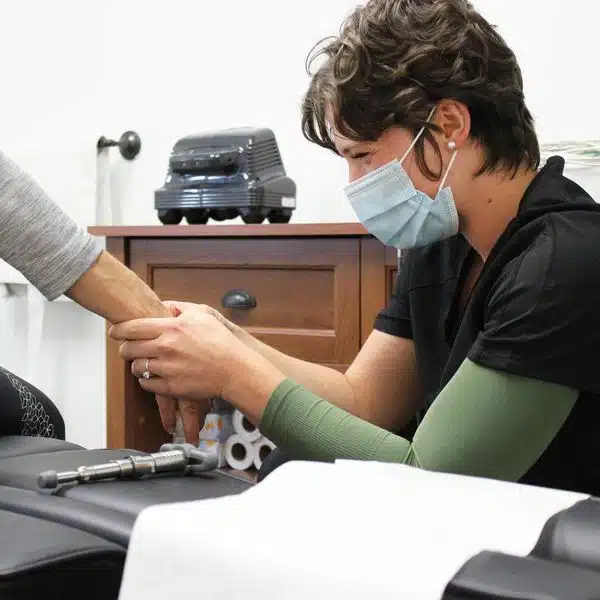
- Home
- About
- Services
- Conditions
- Symptoms
- Patients
- Reviews
- Contact

Wrist pain is one of the most common and overlooked issues among office workers today. Long hours of typing, clicking, and repetitive movements can quietly build tension, eventually leading to conditions like carpal tunnel syndrome.
Wrist pain from your desk job doesn’t just cause discomfort—it can slow you down, reduce your focus, and even lead to long-term wrist injury.
In this article, you’ll learn practical, chiropractor-approved ways to prevent and relieve wrist pain, whether working from home or in the office.
Desk work might seem harmless, but it places steady stress on your hands and wrists. Hours of typing, clicking, and repetitive motions gradually wear down tendons and compress nerves, especially in an office job without proper breaks or support.

The pressure to stay productive is constant for professionals at fast-paced companies like Netflix or Facebook (Meta). Whether it’s coding, writing, or editing, the demands of screen-heavy work show how poor ergonomics can quietly lead to wrist strain over time.
Without proper setup or movement, pressure builds in the joints, and muscle fatigue and inflammation can develop. Many are already searching for wrist pain treatment when discomfort sets in to get through the workday.
It’s easy to dismiss the early signs of a hand or wrist injury—until the pain becomes harder to ignore. Recognizing symptoms early is key to treating wrist pain effectively.
If you spend hours at a desk, these chiropractor-approved tips can make a big difference in easing wrist pain from your desk job.
Keep your wrists straight and neutral—not bent upward or downward—to reduce tension and prevent strain. Using a split, ergonomic keyboard or vertical mouse can ease joint pressure and lower the risk of overuse injuries like trigger fingers.

Without proper ergonomic support at home, many hybrid workers struggle to maintain a healthy setup—often leading to wrist strain. Tools like wrist pads or adjustable armrests help keep forearms level and wrists in a neutral position.
Perform wrist rolls, prayer stretches, and finger extensions every 45–60 minutes. These gentle movements improve circulation and help restore function by releasing tension in the hands and forearms.
Nerve glides are simple, controlled movements that help relieve nerve compression in the median nerve, which runs through the wrist. Chiropractors often recommend them for carpal tunnel relief because they improve mobility and prevent pain from worsening.
Switching your mouse to the opposite hand occasionally reduces repetitive hand strain from doing the same movements all day. It also promotes more balanced muscle use and gives your dominant wrist a break.
Taking breaks every 30 to 45 minutes—standing, walking, or gently shaking out your hands—can make a significant difference. These short pauses reduce stiffness and help prevent your muscles and joints from locking up during prolonged desk work.
Chiropractic care for wrist pain takes a full-body approach—starting with your spine and working through the shoulders, elbows, and wrists. This helps identify hidden causes, like poor posture or misalignments that place extra strain on the hands and wrists.

Treatments may include:
At Allied Pain & Wellness, we've helped professionals across industries—including high-performing tech teams—find wrist pain relief and stay productive at work.
Wrist pain from your desk job is a growing issue you shouldn't ignore. If left untreated, it can lead to long-term damage and impact your daily performance.
Apply these chiropractor-backed strategies to stay comfortable, productive, and on the path to a pain-free workday.
Ready for real relief? Book a consultation with Allied Pain & Wellness. Our team is led by Dr. Shahen Simian, an experienced chiropractor who excels at treating wrist pain with custom plans, helping desk workers feel better and work smarter.

Monday: 9:00am-7:00pm
Tuesday: 9:00am-7:00pm
Wednesday: 9:00am-7:00pm
Thursday: 9:00am-7:00pm
Friday: 9:00am-7:00pm
Saturday: 9:00am-2:00pm
Sunday: Closed